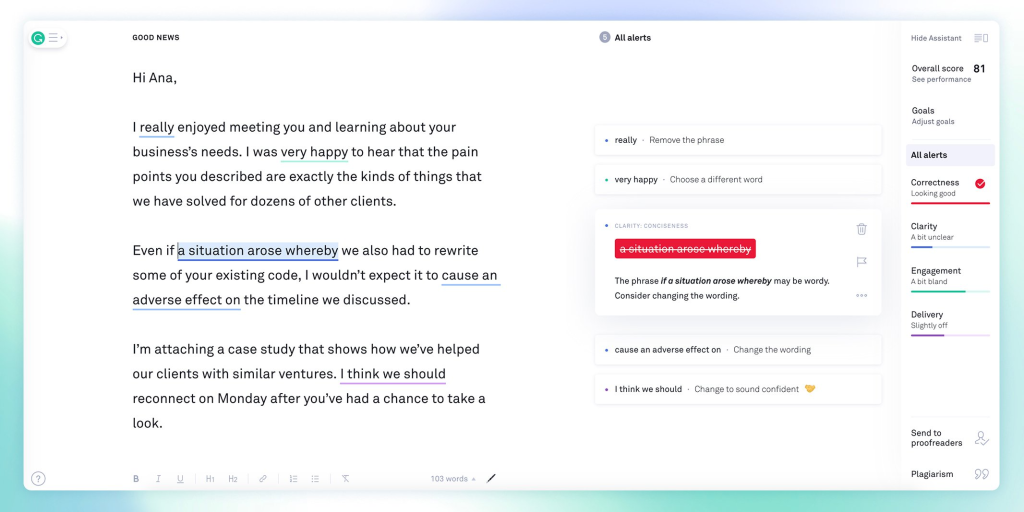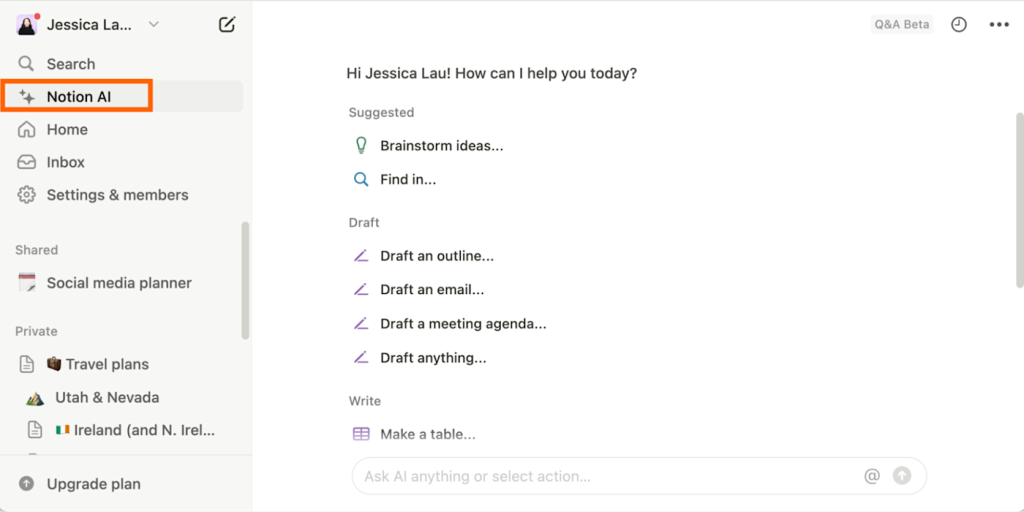
The way we create content is evolving – and fast. As the demands for speed, personalization, and efficiency in communication continue to grow, the AI Writing Assistant is stepping into the spotlight. No longer seen as just a novelty or support tool, AI-powered writing assistants are now an essential part of content strategies across industries.
In 2025, businesses large and small are turning to these tools to streamline writing workflows, reduce costs, and maintain consistent messaging across teams. In this article, we’ll explore what is driving this shift and the top AI Writing Assistant platforms that are quickly becoming indispensable tools in every content creator’s toolkit.
Overview of Best AI Writing Assistant Tools
1. FuseBase – For collaborative, client-facing content workflows
All-in-one AI workspace with brand tone memory, real-time collaboration, client portals, and workflow automation.
2. Jasper – For scalable, brand-consistent marketing content
Generates long- and short-form content with brand voice customization, campaign workflows, and collaboration tools.
3. Grammarly Business – For real-time tone, clarity, and style control
Ensures professional, consistent communication with instant grammar fixes, tone suggestions, style guides, and analytics across platforms.
4. Writesonic – For SEO-optimized, performance-driven content
Supports long-form blogging, ads, and landing pages with built-in SEO tools and integrations.
5. Notion AI – For in-workspace writing and documentation support
Enhances planning and documentation with summarization, rewriting, and brainstorming directly in Notion pages.
6. Copy.ai – For automated short-form and repetitive content
Automates product descriptions, emails, and social posts through workflow triggers, templates, and integrations with CRMs and CMS tools.
What is an AI Writing Assistant Tool
An AI Writing Assistant is a smart content creation tool designed to help users write faster, clearer, and more effectively using artificial intelligence. These assistants are powered by advanced language models trained to understand context, grammar, tone, and writing goals. An AI Writing Assistant can handle a wide variety of communication tasks, from composing emails and blog posts to drafting press releases and reports. The best AI Writing Assistants can adapt to different tones, provide instant feedback, suggest improvements, and even repurpose content across formats. As teams face tighter deadlines and higher output demands, these assistants serve as scalable, always-available partners that help maintain both quality and speed.
Use Cases Across Industries
When used to their full potential, AI Writing Assistants become a dynamic asset across sectors – not just a time-saver, but a strategic advantage.
- Creative agencies and marketing teams use features like tone modulation, multi-format content repurposing, and idea expansion to deliver consistent, high-quality messaging across multiple campaigns and clients. These tools reduce creative fatigue and eliminate redundant rewriting.
- In healthcare and life sciences, AI can summarize dense research documents, turn technical content into plain language, and generate education materials for patients. With the right assistant, teams maintain accuracy while improving accessibility, especially critical in regulated environments.
- Educational institutions and publishers use AI to generate quizzes, rewrite textbook content for different grade levels, and adapt content for mobile or interactive platforms. Features like summarization and structure analysis help turn long-form text into bite-sized, engaging learning materials.
- Real estate professionals rely on AI Writing Assistants to produce listing descriptions, community guides, and market updates. Features like automatic formatting, keyword optimization, and tone adjustment save time and increase consistency in communications.
- Customer support and operations teams use AI to write help documentation, macros for support chats, and internal process manuals. Features like knowledge base integration and tone calibration ensure responses are helpful, on-brand, and scalable across teams.
Key Drivers Behind Adoption of AI Writing Assistant
The rise of the AI Writing Assistant in 2025 is driven by a perfect storm of workplace demands and technological advancement. Here are the key reasons why adoption is accelerating across industries:
- Faster Content Turnaround – Businesses need to publish more, faster. AI helps generate high-quality content in minutes, cutting down production cycles.
- Scalability Without Headcount – Teams are under pressure to do more with less. AI Writing Assistants allow lean teams to scale output without hiring more writers.
- Personalization at Scale – From email campaigns to website copy, AI makes it easier to tailor content for different audiences without manual effort.
- Consistency Across Channels – Maintaining tone and voice across emails, social posts, and blogs is challenging. AI enforces brand standards automatically.
- Better Workflow Integration – Modern assistants integrate with existing tools like Google Docs, CMS platforms, and CRMs, making adoption smooth and efficient.
- Rising Expectations for Quality and Speed – Consumers expect polished, professional content delivered fast. AI bridges the gap by offering tools that not only help with speed but also elevate grammar, tone, and readability in real time.
Top AI Writing Assistant Tools
As AI becomes deeply embedded in how teams work, write, and communicate, AI writing assistants have evolved from optional tools into essential business assets. Here are six of the top-performing AI writing assistant tools in 2025, chosen for their practical value across industries and their ability to keep up with the increasing demands of modern content teams.
1. FuseBase – The Most Complete AI Writing Platform for Collaborative Teams

FuseBase is a true all-in-one AI workspace that brings together writing, collaboration, project management, and client delivery into a single environment. Unlike standalone writing assistants, FuseBase supports every stage of content creation: from idea generation to drafting, editing, client review, and final delivery. FuseBase’s AI assistant helps maintain brand voice and generate high-quality content across formats such as blogs, emails, proposals, task descriptions, internal documentation, and more. What sets it apart is its real-time collaboration features, branded content portals for clients, and automation tools for workflows like approvals, notifications, and file handling.
Pros:
- AI-powered writing with brand tone memory
- Client-facing portals for sharing drafts, files, and approvals
- All-in-one platform for writing, collaboration, and delivery
- Ideal for distributed or agency teams
- Supports both internal and client-facing workflows
- Custom branding and automation built-in
Cons:
- May be more than needed for solo writers
- Requires onboarding to leverage full potential
🤖 Example of how AI Agents transform your work:
2. Jasper – Enterprise-Grade AI Assistant with Brand Voice Capabilities

Jasper is a popular AI content platform built for marketing and sales teams needing consistent, brand-aligned content at scale. With advanced customization options, it can generate long-form articles, short-form copy, ad variants, and email sequences tailored to your voice and objectives. Jasper also supports campaign workflows, shared templates, team folders, and collaboration, making it ideal for multi-person marketing departments or agencies.
Pros:
- Powerful brand consistency features
- 50+ content templates
- Long-form assistant with guided workflows
- Multi-language support
- Great for content marketers and ad copywriters
- Collaboration-ready with roles and permissions
Cons:
- Can be expensive for small teams
- Slight learning curve for new users
3. Grammarly Business – Real-Time Editing, Tone Control, and Style Consistency

Grammarly Business expands on the popular individual version of Grammarly with team-oriented features. It corrects grammar and clarity in real time, while offering tone suggestions, brand-specific style guides, and writing analytics. The tool integrates into browsers, email clients, and word processors, making it great for customer-facing and internal communication where tone and clarity matter.
Pros:
- Extremely easy to implement
- Ensures consistency in tone and professionalism
- Analytics to track writing performance across teams
- Integration with Google Docs, Outlook, Slack, and more
- Works across platforms without disrupting workflow
Cons:
- Limited creative writing or content generation features
- Not ideal for long-form content production
4. Writesonic – SEO-Focused AI Writing for High-Performance Content

Writesonic is a robust AI writing platform focused on helping content marketers, bloggers, and growth teams produce performance-oriented content. It supports long-form blogging, product descriptions, landing pages, and ad copy, along with built-in SEO assistance. The platform features integrations with tools like Surfer SEO and supports AI image generation through Photosonic, giving it unique advantages for content-rich teams aiming to drive traffic.
Pros:
- Great for SEO and conversion-oriented content
- AI blog writer with structure and keyword optimization
- Wide range of writing formats and use cases
- Templates for ads, ecommerce, and landing pages
- Built-in tools reduce reliance on external platforms
Cons:
- Some outputs may require manual refinement
- Interface can be overwhelming for new users
5. Notion AI – Embedded Writing Assistant for Team Collaboration and Documentation

Notion AI brings writing intelligence into your existing Notion workspace. It helps with summarizing documents, rewriting text in different tones, generating outlines, and brainstorming ideas – all inside the pages your team already uses to plan and collaborate. This makes it ideal for marketing teams, product managers, or internal comms professionals who rely heavily on documentation and knowledge sharing.
Pros:
- Seamlessly enhances your existing workspace
- Great for content strategy, planning, and SOPs
- Smart summarization, rewriting, and expansion tools
- Auto-generated outlines, lists, and follow-up actions
- Boosts team productivity with minimal disruption
Cons:
- Lacks advanced campaign templates or SEO features
- Best used as a supporting tool rather than standalone writing assistant
🤖 Another example of AI that transforms how businesses work:
6. Copy.ai – AI Automation for Short-Form and Repetitive Content

Copy.ai has evolved beyond rapid copywriting into an automation-first platform. With its new Workflows feature, teams can automate repetitive content tasks such as drafting product descriptions, follow-up emails, or social media posts – triggered by minimal input or external data. This tool is perfect for ecommerce, sales, and support teams who need high output with low effort. You can even link it to CRMs, CMS tools, and customer feedback systems to generate content automatically based on events or templates.
Pros:
- Huge time savings for repetitive content tasks
- Workflow builder with drag-and-drop actions
- Easy to set up and automate multi-step workflows
- AI-driven personalization
- Templates for product pages, FAQs, email outreach, and ads
- Team workspaces for collaborative editing
Cons:
- Limited creative depth for long-form writing
- Some automation features require technical setup
Conclusion
In 2025, AI Writing Assistants have become essential tools for teams facing ever-growing content demands and tighter deadlines. Among all the innovative solutions available, FuseBase emerges as the most comprehensive option. It not only generates high-quality content but also integrates collaboration, project management, and client delivery into a single, unified platform. By streamlining the entire content creation lifecycle, FuseBase helps teams work smarter and more efficiently. In a world where speed and precision are crucial, FuseBase stands out as the must-have AI writing assistant that elevates team performance and ensures content excellence.

